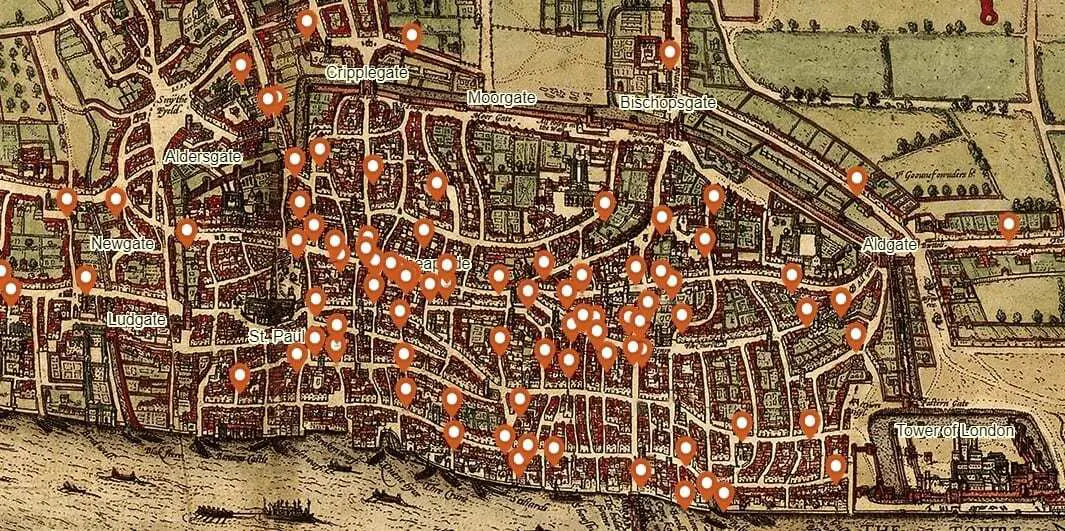Shot with an arrow during a student street brawl. Beaten to death for littering with eel skins. Stabbed by a lover with a fish-gutting knife. Shanked by a sore loser after late-night backgammon.
These were just some of the ways to die violently in the city of London during the 14th century, as catalogued in the ‘Coroners’ Rolls’: the records of the medieval official tasked with documenting sudden and unnatural death – whether accident, suicide or homicide.
Now, University of Cambridge criminologist Professor Manuel Eisner has plotted all cases of murder from the surviving rolls – covering the years 1300 to 1340 – onto a digital map of the old city to show for the first time the ‘hot spots’ of lethal violence in medieval London.
Building on work conducted by the historian Barbara Hannawalt over forty years ago, Eisner has also produced an analysis of the 142 homicides committed within the city’s boundaries to reveal not just locations but the days, times and favoured methods.
The “murder map” of medieval London will be made publicly available on Wednesday on the website of the Violence Research Centre at Cambridge University, which will also host a launch event.
“Following notification of a violent death, the Coroner and Sheriffs would summon a jury from the local area to investigate, then record all the findings,” said Eisner.
“The events described in the Coroners’ Rolls show weapons were never far away, male honour had to be protected, and conflicts easily got out of hand. They give us a detailed picture of how homicide was embedded in the rhythms of urban medieval life.”
“By digitally mapping these murder cases, we hope to create an accessible resource for the public to explore these remarkable records,” he said.
Eisner’s map allows people to filter the murders by year, weapon and crime scene, and has updated the language of each case description for modern audiences.
While the map shows murders occurred across the city, two main homicide ‘hot spots’ emerge, both commercial centres of the time. One was the stretch of Cheapside from St Mary-le-Bow church – the ‘bow bells’ of cockney legend – leading up to St Paul’s Cathedral.
The other was further east: the triangle of Gracechurch, Lombard (then ‘Langbourn’) and Cornhill streets that radiate out from Leadenhall market, the history of which can be traced back to the 14th century.
The majority of murders, some 68%, took place in London’s busy streets and markets, with 21% occurring in private residences. Religious buildings (six murders) may have been more dangerous than brothels (two murders).
As today, medieval homicide was a weekend activity, with almost a third (31%) of murders taking place on a Sunday. “Sunday was the day when people had time to engage in social activities, such as drinking and gaming, which would often trigger frictions that led to assault,” said Eisner.
Around 77% of murders were committed between early evenings, “around the hour of vespers”, and the first hours after curfew. Daggers and swords dominate the list of murder weapons, used in 68% of all cases. Thick ‘quarter staff’ poles designed for close combat were used in 19% of cases.
Almost all (92%) perpetrators were men. In just four cases a woman was the only suspect. About a third of the cases had more than one suspect, with a number of murders involving brothers or servants helping masters.
Estimates for London populations in the 14th century range from 40,000 to 100,000. Assuming a city of 80,000, Eisner suggests that medieval London murder rates were about 15-20 times higher than we would expect to see in a contemporary UK town of equivalent size.
However, he argues that comparisons with modern society are problematic. “We have firearms, but we also have emergency services. It’s easier to kill but easier to save lives.”
In fact, death by murder could be a slow process in the 14th century. “Over 18% of victims survived at least a week after the initial trauma, probably dying eventually from infections or blood loss,” said Eisner.
One saddle-maker who had his fingers cut off by a rival died of his wounds – and consequently became a murder victim – a full three weeks later.
While his work takes in everything from bullying prevention to youth crime, violence reduction across the centuries is a major research strand for Prof Eisner. He has studied long-term historical trends in homicide from 1000AD onwards.
“London in the decades before the Black Death had more homicides relative to the population than London in the 18th or 19th century,” added Eisner.
“The trend in London is in line with the long-term decline of homicide found across cities in Western Europe, a decline that led to the pacified spaces that were essential for the rise of urban life and civility in Europe.”





